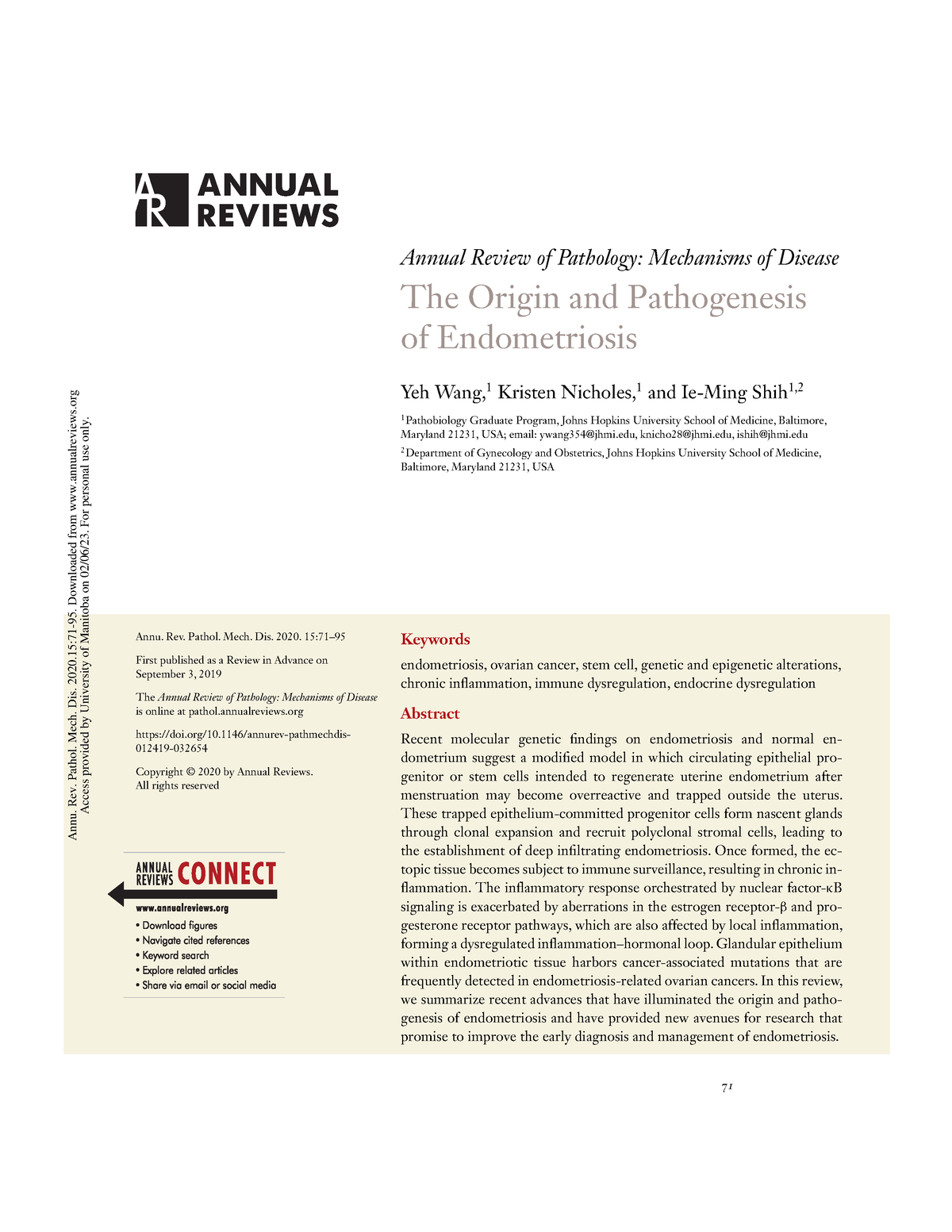The Origin and Pathogenesis of Endometriosis.
IF 28.4
1区 医学
Q1 PATHOLOGY
Annual Review of Pathology-Mechanisms of Disease
Pub Date : 2020-01-24
DOI:10.1146/annurev-pathmechdis-012419-032654
引用次数: 182
Abstract
Recent molecular genetic findings on endometriosis and normal endometrium suggest a modified model in which circulating epithelial progenitor or stem cells intended to regenerate uterine endometrium after menstruation may become overreactive and trapped outside the uterus. These trapped epithelium-committed progenitor cells form nascent glands through clonal expansion and recruit polyclonal stromal cells, leading to the establishment of deep infiltrating endometriosis. Once formed, the ectopic tissue becomes subject to immune surveillance, resulting in chronic inflammation. The inflammatory response orchestrated by nuclear factor-κB signaling is exacerbated by aberrations in the estrogen receptor-β and progesterone receptor pathways, which are also affected by local inflammation, forming a dysregulated inflammation-hormonal loop. Glandular epithelium within endometriotic tissue harbors cancer-associated mutations that are frequently detected in endometriosis-related ovarian cancers. In this review, we summarize recent advances that have illuminated the origin and pathogenesis of endometriosis and have provided new avenues for research that promise to improve the early diagnosis and management of endometriosis. Expected final online publication date for the Annual Review of Pathology: Mechanisms of Disease, Volume 15 is January 24, 2020. Please see http://www.annualreviews.org/page/journal/pubdates for revised estimates.子宫内膜异位症的起源和发病机制。
最近对子宫内膜异位症和正常子宫内膜的分子遗传学发现表明,一种改良的模型,在该模型中,旨在月经后再生子宫内膜的循环上皮祖细胞或干细胞可能会反应过度并被困在子宫外。这些被捕获的上皮转化祖细胞通过克隆扩增形成新生腺体,并募集多克隆基质细胞,导致深浸润性子宫内膜异位症的建立。异位组织一旦形成,就会受到免疫监视,从而导致慢性炎症。核因子-κB信号传导所协调的炎症反应因雌激素受体-β和孕激素受体通路的异常而加剧,这些通路也受到局部炎症的影响,形成失调的炎症激素回路。子宫内膜异位组织内的腺上皮含有癌症相关突变,在子宫内膜异位相关卵巢癌中经常检测到。在这篇综述中,我们总结了阐明子宫内膜异位症起源和发病机制的最新进展,并为有望改善子宫内膜异位的早期诊断和管理的研究提供了新的途径。《病理学年度评论:疾病机制》第15卷预计最终在线出版日期为2020年1月24日。请参阅http://www.annualreviews.org/page/journal/pubdates用于修订估算。
本文章由计算机程序翻译,如有差异,请以英文原文为准。
求助全文
约1分钟内获得全文
求助全文
来源期刊
CiteScore
62.60
自引率
0.00%
发文量
40
期刊介绍:
The Annual Review of Pathology: Mechanisms of Disease is a scholarly journal that has been published since 2006. Its primary focus is to provide a comprehensive overview of recent advancements in our knowledge of the causes and development of significant human diseases. The journal places particular emphasis on exploring the current and evolving concepts of disease pathogenesis, as well as the molecular genetic and morphological changes associated with various diseases. Additionally, the journal addresses the clinical significance of these findings.
In order to increase accessibility and promote the broad dissemination of research, the current volume of the journal has transitioned from a gated subscription model to an open access format. This change has been made possible through the Annual Reviews' Subscribe to Open program, which allows all articles published in this volume to be freely accessible to readers. As part of this transition, all articles in the journal are published under a Creative Commons Attribution (CC BY) license, which encourages open sharing and use of the research.

 求助内容:
求助内容: 应助结果提醒方式:
应助结果提醒方式:


